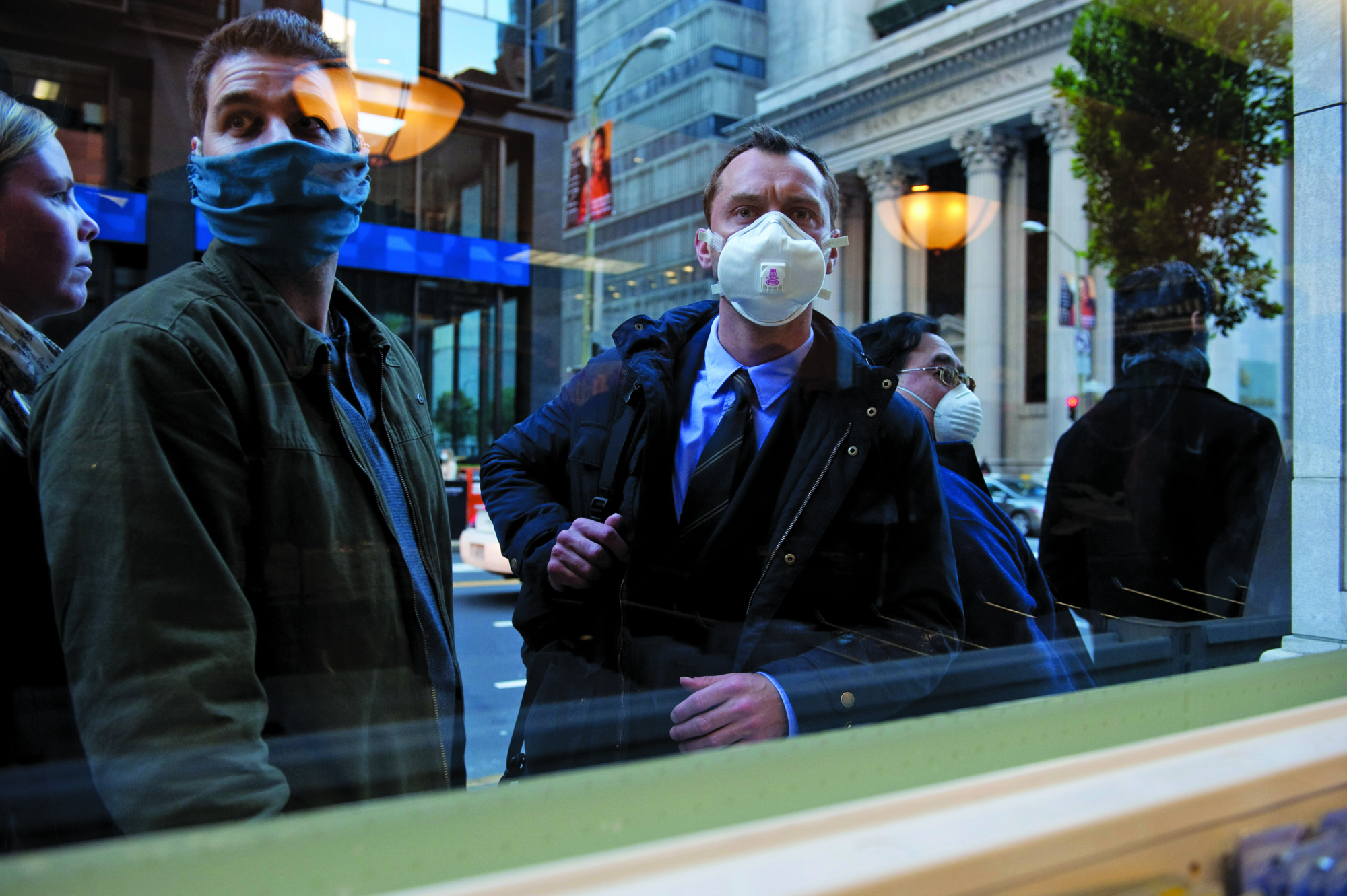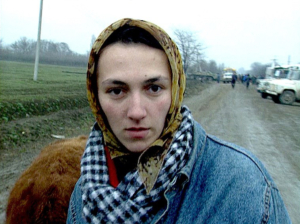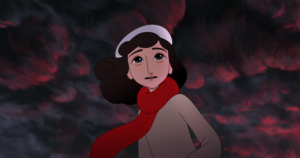Hollywood movies with realistic science come along about as often as global pandemics. Which might explain why, as the scourge of COVID-19 began to sweep the globe, audiences returned to Steven Soderbergh’s 2011 pandemic thriller Contagion.[1]See, for example, Ella Torres, ‘Cast of Contagion Issues PSA on Coronavirus Pandemic’, ABC News (US), 29 March 2020, <https://abcnews.go.com/Entertainment/cast-contagion-issues-psa-coronavirus-pandemic/story?id=69853838>, accessed 7 May 2020. While the film was moderately well received in its time,[2]With an 84 per cent positive rating on Rotten Tomatoes, if you put any stock in that sort of thing. See ‘Contagion’, Rotten Tomatoes,<https://www.rottentomatoes.com/m/contagion_2011>, accessed 7 May 2020. its success as a drama was arguably undercut by its emphasis on accurate science – an emphasis that makes the film especially relevant in light of recent events.
Flitting between victims, doctors and con men variously surviving, fighting and exploiting a pandemic crisis, Contagion prioritises rigorously researched science each step of the way. New Scientist’s review, for instance, noted that it had ‘been well fact-checked compared to most science-y blockbusters’.[3]Ferris Jabr, ‘How Realistic Is Contagion? The Movie Doesn’t Skimp on Science’, New Scientist, 6 April 2020, <https://www.newscientist.com/article/2239913-how-realistic-is-contagion-the-movie-doesnt-skimp-on-science/>, accessed 7 May 2020. Such an approach, though, can detract from a film’s entertainment value; another review described Contagion as ‘a surprisingly clinical work that leaves us feeling we have just sat through a lengthy news feature on CNN’.[4]Andrew L Urban, ‘Contagion’, The Sydney Morning Herald, 16 October 2011, <https://www.smh.com.au/entertainment/movies/contagion-20111015-1lprk.html>, accessed 7 May 2020.
That perfectly positions Soderbergh’s film as an educational resource. Many Maths and Science teachers have undoubtedly already availed themselves of the opportunity to link their curricula to the coronavirus pandemic, but the ever-changing information around the situation makes that complicated – not to mention the potential for upsetting or scaring students. Contagion is an excellent vehicle for an investigation of the science and mathematics associated with pandemics – vaccines, exponential growth, genetic mutations – in a comparatively safe, fictionalised context.
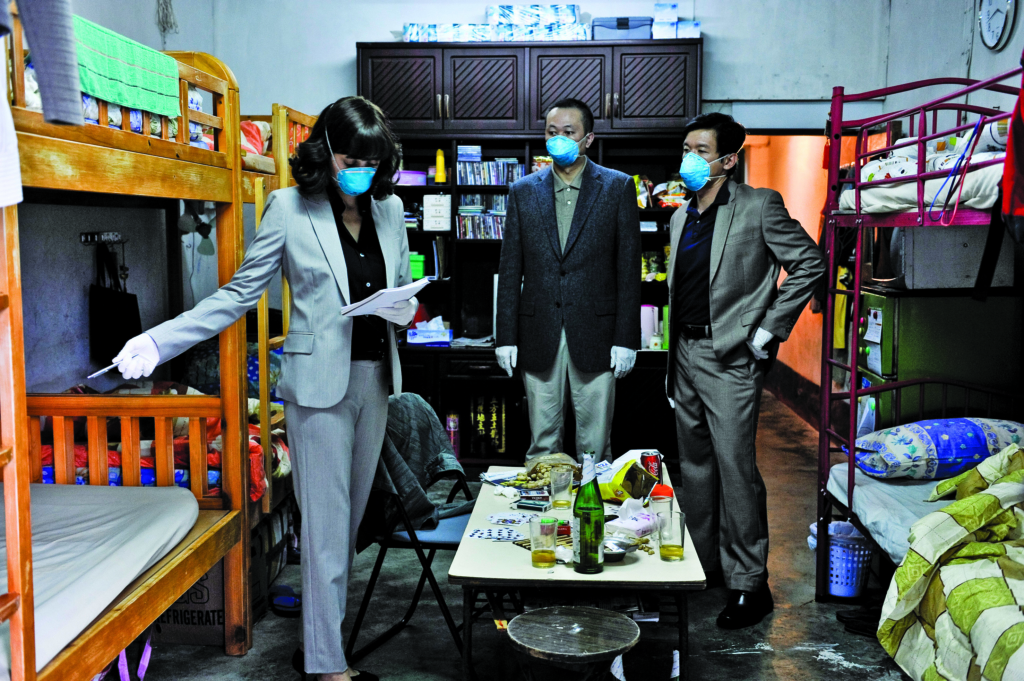
All that said, I would recommend caution with your framing of the film in classrooms. Thanks to its scientific spine, Contagion has plenty of spooky similarities to the real-life COVID-19 crisis. But it is a fictional representation of a far deadlier virus, so managing your students’ potential anxieties and uncertainties when discussing such subject matter should be carefully considered before incorporating this film – or excerpts thereof – into a unit of work.
Vaccines and viruses
It’s fair to say that community understanding of infectious diseases is lacking. The distinction between antibiotics and vaccines is unclear to many, with vaccines in particular proving contentious in contemporary politics. This can be credited to a general distrust of scientists, often stemming from a misunderstanding of the underlying principles of their discipline, so it’s more important than ever for students to leave our educational institutions with a solid understanding of the underlying science of viruses and vaccines.
Unlike bacterial infections, which can be treated with antibiotics, viral infections can’t be ‘cured’ in the conventional sense of the word.[5]See Tom Avril, ‘Why the Coronavirus and Most Other Viruses Have No Cure’, The Philadelphia Inquirer, updated 18 March 2020, <https://www.inquirer.com/health/coronavirus/coronavirus-covid19-antiviral-cure-antibiotic-20200318.html>, accessed 7 May 2020. That’s largely down to how viruses operate; unlike their living bacterial counterparts, they instead ‘hijack’ our cells to reproduce, meaning that they can’t be combated directly. In order to understand viruses, you first need to understand cellular biology – making Contagion and its fictional MEV-1 virus an inspired introduction to a secondary Biology unit.
In order to understand viruses, you first need to understand cellular biology – making Contagion and its fictional MEV-1 virus an inspired introduction to a secondary Biology unit.
One of the film’s subplots centres on rogue reporter–turned–conspiracy theorist Alan Krumwiede (Jude Law). Alan becomes a prophetic, disruptive figure thanks to his promotion of a cure for the film’s virus: a homeopathic remedy derived from forsythia. This is revealed as a scam at the story’s conclusion. This plot point was frequently referenced as the likes of US President Donald Trump promoted hydroxychloroquine – a treatment for malaria – as a possible solution to COVID-19.[6]See Kristen Rogers, ‘Contagion vs. Coronavirus: The Film’s Connections to a Real Life Pandemic’, CNN, 2 April 2020, <https://edition.cnn.com/2020/04/02/movies/contagion-movie-versus-coronavirus-scn-wellness/index.html>, accessed 7 May 2020.
But while viruses might not be able to be cured, per se, they’re not impervious to treatment. Granted, at the time of writing, the US Food and Drug Administration’s advice relating to hydroxychloroquine is that it has ‘not been shown to be safe and effective for treating or preventing’ COVID-19.[7]Cited in Julia Carrie Wong, ‘Hydroxychloroquine and Coronavirus: A Guide to the Scientific Studies So Far’, The Guardian, 25 April 2020, <https://www.theguardian.com/world/2020/apr/22/hydroxychloroquine-coronavirus-scientific-studies-research>, accessed 7 May 2020. But other treatments show promise; for instance, a University of Alberta study found that ‘the drug remdesivir is highly effective in stopping the replication mechanism’[8]‘Study Finds Remdesivir Effective Against a Key Enzyme of Coronavirus That Causes COVID-19’, ScienceDaily,13 April 2020, <https://www.sciencedaily.com/releases/2020/04/200413144055.htm>. A subsequent study, however, found that remdesivir ‘was not associated with statistically significant clinical benefits’ for COVID-19 patients; see Yeming Wang et al., ‘Remdesivir in Adults with Severe COVID-19: A Randomised, Double-blind, Placebo-controlled, Multicentre Trial’, The Lancet, 29 April 2020, <https://www.thelancet.com/journals/lancet/article/PIIS0140-6736(20)31022-9/fulltext>, both accessed 7 May 2020. of COVID-19. The wording of that quote is important; while, unlike bacteria, it’s difficult to target a virus directly, its progress can be slowed or stopped by targeting the cellular mechanisms that facilitate its replication, such as the associated enzymes. More connections to cellular biology!
Such antiviral treatments, though occasionally effective, are limited in their application; often, they’re only effective early in the piece, before the virus takes over too many of our cells as its own little virus factories. They’re also limited in that, in attacking components of our cellular processes (like enzymes), they can do as much harm as good.

The better option is a successful vaccine. The development and distribution of a MEV-1 vaccine forms a significant plank of Contagion’s storyline, and, similarly, the race for a COVID-19 vaccine has dominated global headlines. This presents a great opportunity to investigate not only the history and science associated with vaccines, but also the industrial and commercial realities of producing, testing and distributing them – some of which are suggested by the film in the sequence wherein Dr Leonora Orantes (Marion Cotillard), a World Health Organization epidemiologist, is abducted and held hostage to guarantee prioritised delivery of the vaccine.
Exponential growth
Many of Contagion’s characters are epidemiologists – essentially, epidemics experts – who need to explain the particulars of pandemic science to decision makers who are decidedly not experts. This common screenwriting technique allows us, as audience members, to assume the role of layperson and listen along to the explanations with the equally perplexed politicians.
One such scene plays out much like a high school lesson, as Dr Ellis Cheever (Laurence Fishburne) from the US Centers for Disease Control and Prevention explains the concept of R0 (‘R nought’) on a whiteboard. Quantifying the R0, or reproduction number, of an infectious disease is critical to evaluating the speed at which it will spread.[9]See Vanessa Bates Ramirez, ‘What Is R0? Gauging Contagious Infections’, Healthline, 20 April 2020, <https://www.healthline.com/health/r-nought-reproduction-number>, accessed 7 May 2020. Many of the interventions – from commercial shutdowns to social distancing – introduced in the wake of the coronavirus outbreak are intended to reduce this number as much as possible (while, technically, this reduced number is R, the effective reproductive number – as opposed to R0, the basic reproduction number[10]See ‘2.2 The Reproduction Number’ in Commonwealth of Australia, Using Mathematical Models to Assess Responses to an Outbreak of an Emerged Viral Respiratory Disease’, April 2006, <https://www1.health.gov.au/internet/publications/publishing.nsf/Content/mathematical-models~mathematical-models-models.htm~mathematical-models-2.2.htm>, accessed 7 May 2020. – this distinction isn’t critical to understand at a secondary school level). Indeed, one of the goals of such restrictions is to reduce the reproduction number below 1.
Understanding the concept of the reproduction number of an infectious disease is necessary, then, to understand the challenges presented by COVID-19, and the reasoning behind the actions taken by countries across the world to restrict its spread. But, in Mathematics, it also serves as an incredibly helpful introduction into the world of exponential relationships!
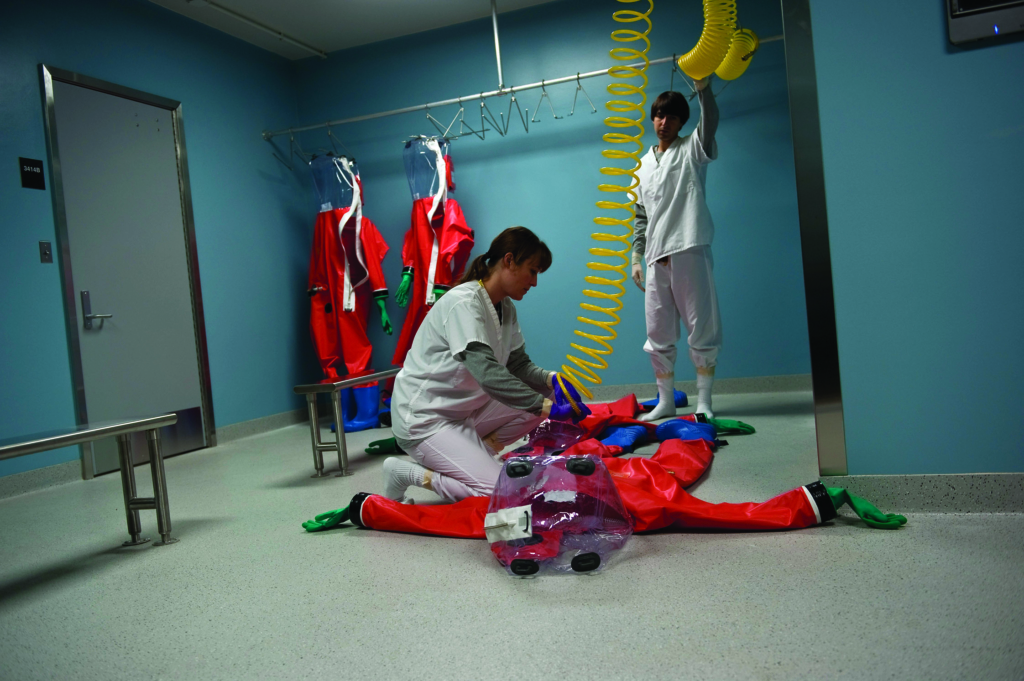
The spread of an infectious disease with a constant reproduction number through a population will, at least initially, operate as an exponential model. Whether introducing students to the concept of exponential functions or reinforcing their understanding of the underlying concepts, exploring this is a great way to demonstrate both the relevance of these models and some of their key characteristics.[11]I considered suggesting an incorporation of the reproduction number and the mortality rate to allow for a fuller, more complex modelling of infectious disease, but ultimately decided it was a tad too morbid under the present circumstances. Your mileage may vary. For example, it’s clear that if a large population is infected, then the virus will spread more quickly – which aligns with the property of exponential models that their rate of change is directly proportional to the population (in this case, the infected population).
Considering exponential functions in the context of a pandemic also underlines the limitations of these functions in real-world concepts. For starters, the reproduction number is an average – you don’t expect to see precisely the same growth per person or per day. Also, it should be clear that the virus can’t spread forever, as, at a certain point, everyone will either be infected, recovered, immune … or dead. At more specialised levels of Mathematics, this can be used to segue into the logistic curve, a function that initially follows an exponential relationship before settling into an equilibrium as it approaches its ‘ceiling’, or upper limit.
Finally, while we’re on the topic of exponential models: Mathematics teachers would know that the name comes from the nature of functions, where the independent variable is the exponent or index of a number. As such, we tend to explore these models in the context of index and logarithm laws. While initial applications of logarithms tend to be pretty abstract, incorporating the context of infectious diseases allows not only for the solving of life-related problems – for example, if the reproduction number was 3, how long would it take for 50,000 people to be infected from one initial patient? – but also for an understanding of how COVID-19 data is represented. Most graphs plotting the spread of the virus use a logarithmic scale, which provides yet another hook to a unit centring on logarithms.

Genetic mutations
Contagion concludes with a flashback revealing the origin of MEV-1: a piece of banana, half-eaten by a bat, is consumed by a pig, and blood from said slaughtered pig infects ‘patient zero’, Beth Emhoff (Gwyneth Paltrow). We have no such certainty over the origins of COVID-19 – and likely never will – but, at the time of writing, one of the more credible hypotheses is remarkably similar: that the virus passed from bats to humans via pangolins[12]See Yang Zhang, Chengxin Zhang & Wei Zheng, ‘Study Shows Pangolins May Have Passed New Coronavirus from Bats to Humans’, The Conversation, 10 April 2020, <https://theconversation.com/study-shows-pangolins-may-have-passed-new-coronavirus-from-bats-to-humans-135687>, accessed 7 May 2020. (though conspiracy theories about lab-grown diseases abound, naturally, even within the upper echelons of the US Government[13]See Paul Rincon, ‘Coronavirus: Is There Any Evidence for Lab Release Theory?’, BBC News, 1 May 2020, <https://www.bbc.com/news/science-environment-52318539>, accessed 7 May 2020.).
Though delving into the particulars of how ‘novel’ viruses originate – how animal diseases jump to humans – might be beyond the scope of a secondary school curriculum, investigating associated concepts of genetics and mutation is not. Indeed, Contagion even devotes a short scene to an examination of MEV-1’s genetic code in comparison with similar viruses, allowing scientists to identify its likely origins based purely on genetic analysis.
We typically talk about evolution from a macro perspective – giraffes’ long necks evolving to access the leaves atop trees, and so on. The appearance of fictional viruses like MEV-1 or real viruses like COVID-19 is a slightly less pleasing example of evolution. Just like larger organisms, viruses want to thrive, and what better way to thrive than mutating into a form that can access an entirely new species population? Thus we have an excellent demonstration of the randomness of evolution – it’s not like COVID-19 had any intent associated with these mutations – and how small mutations can have huge effects.
Only a small step sideways could take a classroom into a discussion of the challenges presented by ‘super germs’: bacteria with an evolved immunity to a range of antibiotics due to the downsides of modern medicine. Though not strictly related to Contagion or COVID-19 – after all, one doesn’t use antibiotics to treat viral infections, as discussed – the concepts will combine to give students a fuller understanding of evolution in the context of random genetic mutations.
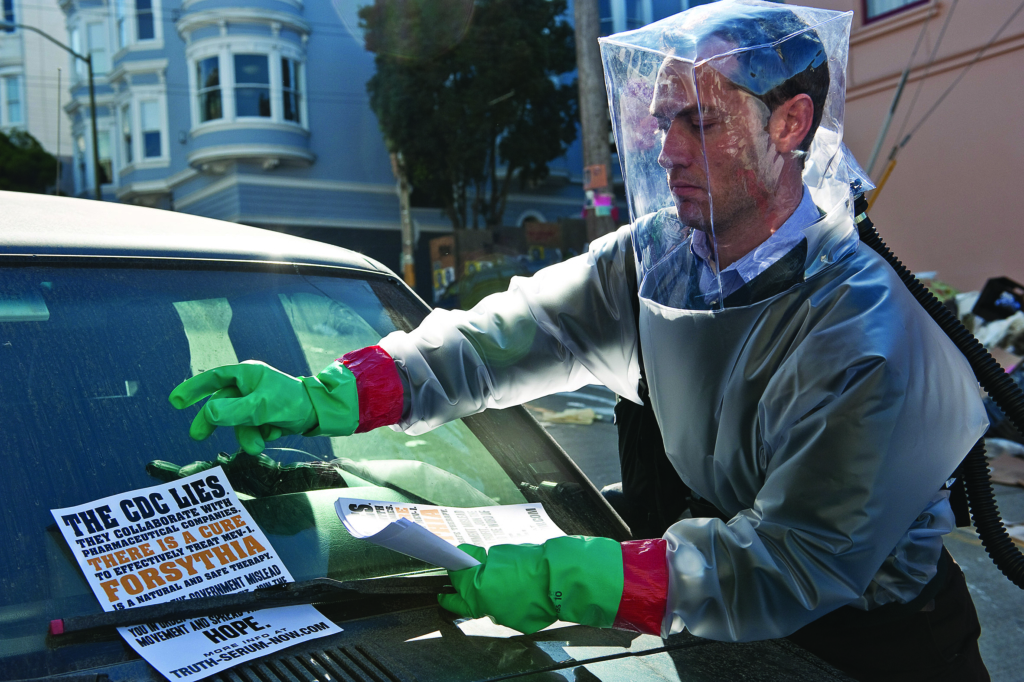
Odds and ends
There’s a whole lot more excellent science nestled within Contagion. Indeed, it’s somewhat eerie rewatching the film in the wake of COVID-19 and hearing Dr Erin Mears (Kate Winslet) admonish a co-worker not to touch his face, or seeing the camera linger on surfaces – ‘fomites’[14]A term for surfaces or objects that can transfer diseases. Oddly, one of those technical terms that didn’t quite capture the social imagination like, say, ‘social distancing’. – touched by infected characters. Not only does discussing the science associated with such transmission have educational value from a curriculum standpoint, it also helps ensure that students can make informed decisions about their own hygiene.
Similarly, with contact tracing a huge part of combating COVID-19, it’s instructive to rewatch the scene in which Leonora digs through casino footage to try and identify just whom Beth – our patient zero – came into contact with. This is just one example of the film’s preoccupation with administrative challenges, many of which open up productive ethical conversations in the classroom. For example, how would you fairly distribute a life-saving vaccine when constrained by supply and finances alike?
Endnotes
| 1 | See, for example, Ella Torres, ‘Cast of Contagion Issues PSA on Coronavirus Pandemic’, ABC News (US), 29 March 2020, <https://abcnews.go.com/Entertainment/cast-contagion-issues-psa-coronavirus-pandemic/story?id=69853838>, accessed 7 May 2020. |
|---|---|
| 2 | With an 84 per cent positive rating on Rotten Tomatoes, if you put any stock in that sort of thing. See ‘Contagion’, Rotten Tomatoes,<https://www.rottentomatoes.com/m/contagion_2011>, accessed 7 May 2020. |
| 3 | Ferris Jabr, ‘How Realistic Is Contagion? The Movie Doesn’t Skimp on Science’, New Scientist, 6 April 2020, <https://www.newscientist.com/article/2239913-how-realistic-is-contagion-the-movie-doesnt-skimp-on-science/>, accessed 7 May 2020. |
| 4 | Andrew L Urban, ‘Contagion’, The Sydney Morning Herald, 16 October 2011, <https://www.smh.com.au/entertainment/movies/contagion-20111015-1lprk.html>, accessed 7 May 2020. |
| 5 | See Tom Avril, ‘Why the Coronavirus and Most Other Viruses Have No Cure’, The Philadelphia Inquirer, updated 18 March 2020, <https://www.inquirer.com/health/coronavirus/coronavirus-covid19-antiviral-cure-antibiotic-20200318.html>, accessed 7 May 2020. |
| 6 | See Kristen Rogers, ‘Contagion vs. Coronavirus: The Film’s Connections to a Real Life Pandemic’, CNN, 2 April 2020, <https://edition.cnn.com/2020/04/02/movies/contagion-movie-versus-coronavirus-scn-wellness/index.html>, accessed 7 May 2020. |
| 7 | Cited in Julia Carrie Wong, ‘Hydroxychloroquine and Coronavirus: A Guide to the Scientific Studies So Far’, The Guardian, 25 April 2020, <https://www.theguardian.com/world/2020/apr/22/hydroxychloroquine-coronavirus-scientific-studies-research>, accessed 7 May 2020. |
| 8 | ‘Study Finds Remdesivir Effective Against a Key Enzyme of Coronavirus That Causes COVID-19’, ScienceDaily,13 April 2020, <https://www.sciencedaily.com/releases/2020/04/200413144055.htm>. A subsequent study, however, found that remdesivir ‘was not associated with statistically significant clinical benefits’ for COVID-19 patients; see Yeming Wang et al., ‘Remdesivir in Adults with Severe COVID-19: A Randomised, Double-blind, Placebo-controlled, Multicentre Trial’, The Lancet, 29 April 2020, <https://www.thelancet.com/journals/lancet/article/PIIS0140-6736(20)31022-9/fulltext>, both accessed 7 May 2020. |
| 9 | See Vanessa Bates Ramirez, ‘What Is R0? Gauging Contagious Infections’, Healthline, 20 April 2020, <https://www.healthline.com/health/r-nought-reproduction-number>, accessed 7 May 2020. |
| 10 | See ‘2.2 The Reproduction Number’ in Commonwealth of Australia, Using Mathematical Models to Assess Responses to an Outbreak of an Emerged Viral Respiratory Disease’, April 2006, <https://www1.health.gov.au/internet/publications/publishing.nsf/Content/mathematical-models~mathematical-models-models.htm~mathematical-models-2.2.htm>, accessed 7 May 2020. |
| 11 | I considered suggesting an incorporation of the reproduction number and the mortality rate to allow for a fuller, more complex modelling of infectious disease, but ultimately decided it was a tad too morbid under the present circumstances. Your mileage may vary. |
| 12 | See Yang Zhang, Chengxin Zhang & Wei Zheng, ‘Study Shows Pangolins May Have Passed New Coronavirus from Bats to Humans’, The Conversation, 10 April 2020, <https://theconversation.com/study-shows-pangolins-may-have-passed-new-coronavirus-from-bats-to-humans-135687>, accessed 7 May 2020. |
| 13 | See Paul Rincon, ‘Coronavirus: Is There Any Evidence for Lab Release Theory?’, BBC News, 1 May 2020, <https://www.bbc.com/news/science-environment-52318539>, accessed 7 May 2020. |
| 14 | A term for surfaces or objects that can transfer diseases. Oddly, one of those technical terms that didn’t quite capture the social imagination like, say, ‘social distancing’. |
